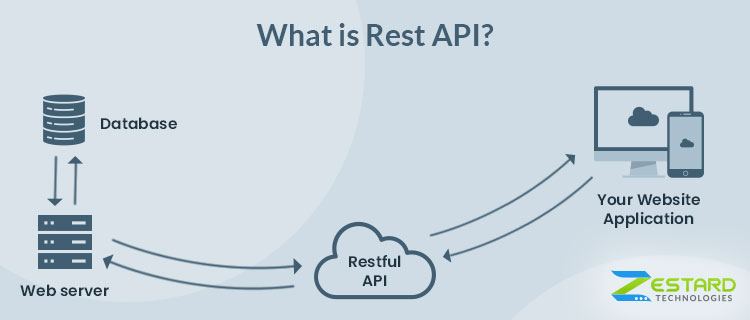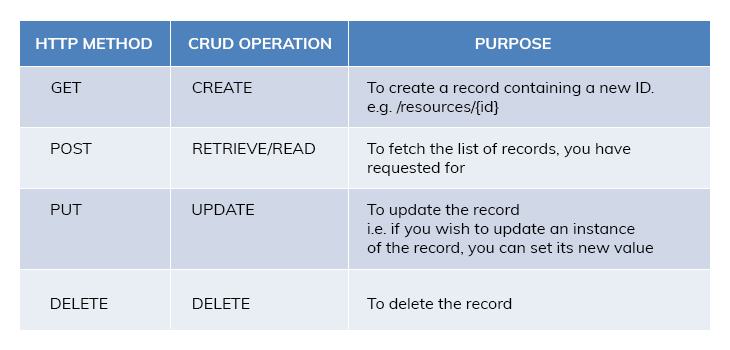The invention and evolution of the internet have made the impossible possible. Now, developers across the globe can develop real-time applications and leverage resources. This is all possible due to the revolution APIs bring to establish communication between the client and the server.

Roy Fielding presented an architectural style named REpresentational State Transfer (REST) in 2000. It is a protocol used for communication purposes, widely used in diverse web service development applications.
The whole purpose is to establish a client-server communication to obtain the resources from a trusted and secured server. The World Wide Web uses the REST protocol to provide a hypermedia driven interface for websites. Thus, REST API supports multiple formats along with HTML.
1. But How Does REST Actually Work?
REST suggests the developers create a data object that a client requests and then send the object value in response from the server to the client or user. For instance, if a user requests a particular food item in a specific locality, then you need to create an object on the server-side.
So, now you have an object of the data the user is requesting for, and you are sending the state of the object. Thus, REST transfers the state of an object of data requested by the client from the web or application server.
Due to its architectural style, REST helps in consuming minimal bandwidth. This makes the applications more suitable for the internet. Often described as the “language of the internet”, this protocol is completely based on the resources.
2. Important Principles of REST API
REST has its major principles and guiding constraints like the other architectural style. Dr Fielding defined the design of this style in 2000 and has laid down the six principles that define it. The guiding principles of REST API are listed below:
- Stateless
The requests from the client to the server must consist of all the vital information. This information can be in the form of query string parameters, body parameters, part of a URL, or headers, thus making the server understand the requests.
The URL identifies the resources uniquely, and the body holds the state of the requesting resource. On processing the client’s request, the server sends a response to the client through status, headers, or body.
- Client-Server Architecture
The client-server architecture enables a separation of concerns, in layman terms, separating the client from the servers. This enhances the scalability of the server components, and the portability of the user interface across diverse platforms. - Cacheable
For faster and better performances, developers create applications that are often cacheable. To enable the caching, one has to implicitly or explicitly label the server response as non-cacheable or cacheable.
If the server response is labelled as cacheable, then the browser or application cache can reuse the response data for the future equivalent responses.
- Uniform Interface
To achieve uniformity in interface throughout the application, diverse interface constraints are required to direct the component behaviours. REST has these interface constraints:
- Identification of the resources
- Manipulation of resources using representations
- Self-descriptive messages
- Hypermedia that works as an engine of the state of the application
- Layered System
This allows the application to limit the component behaviour making it more stable. Such architecture enhances the application’s security as the component’s interaction gets limited to the layer itself. This provides stability due to the shared caches. Also, it supports load balancing. - Code On Demand
This allows the applets or client code to be downloaded. It also allows the code or applet to be used within the apps. However, it is an optional constraint. In a nutshell, it simplifies clients by developing a smart interactive application without relying on its own code architecture.
3. Methods of REST API
REST APIs enable developers to create web applications of all kinds to perform the CRUD operations (Create, Retrieve, Update, Delete). As per the REST guidelines, to make calls to the server, one must use the Web HTTP methods.
Here are the four most important HTTP methods and their equivalent CRUD operations to obtain the required resources from the server.

Advantages of REST API
REST API emerges out to be one of the best alternatives to the other software architectures like Simple Object Access Protocol (SOAP) API due to an array of benefits.
While the REST API has taken over the world of web services, they overcome the limitations posed by that of SOAP. REST is capable of multiple resource management using a few operations, whereas SOAP requires many operations to accomplish the same.
We will discuss the advantages of REST over other architectural styles and what more REST API offers to its users.
- Lightweight
- Simple
- Consumes less bandwidth
- Efficient, faster, and high-performance
- Easy to understand
- Easily adaptable
- Highly flexible and scalable
- Niche documentation
- Low usage of the resources
- Cleaner, safer, and easy to implement
- Ability to handle heavy load due to HTTP caching and proxy server
- Permits all kind of data formats
- Makes complex structured applications easily understandable and organized
- Authenticates API calls using OAuth protocol, thus providing standard-based security
- Serializes data in either XML or JSON format, ensuring flexible data formats
- Depends primarily on code and not on the resources
- Best for cloud-based applications due to stateless calls
- Uses standard HTTP methods to make subsequent requests to the server and retrieve information
4. Why choose REST?
Every developer’s first preference has been REST over other APIs because of the various benefits it offers on a wide scale. Let us know why they trust this protocol while leveraging enormous resources online and why should you choose REST.
- Scalability
REST API emerges out as the strongest one due to its scalability. This is primarily due to the client-server architecture it offers. This protocol provides a clean separation between the client and server, thus allowing the development team to scale the provide with ease. - Supportability
Developers favour various languages like XML or JSON, and REST API is open to adapt all of them. Thus, one of the biggest advantages of internal language is that it open to accept all the formats. Thus, tech giants like Google, Microsoft leverage this software architecture and teach in their tools. - Flexibility
The REST API creates small modules of a transaction by breaking it down. These chunks of modules then address a specific part of the transaction. This modularization approach provides flexibility. However, it requires a lot of effort too, as the application needs to be built from the ground level. - Independence
Due to the uniform interface, REST makes the development process an easy task across the areas of the project. It provides a separation between the client and server, thus reducing the dependency on individual tasks.
Moreover, the REST API is highly adaptable to the platform, environment, and syntax. This offers developers a sense of independence to experiment with various environments.
Leverage REST APIs for development purposes, considering the beneficial factors stated above. The flexibility and scalability delivered by REST is second to none, ensuring this API scores over all others.


